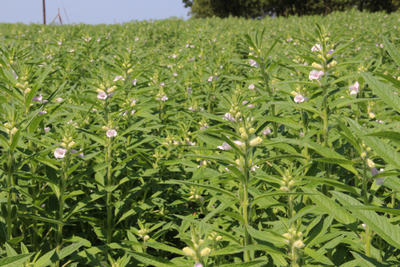
Mississippi sweet potatoes — strong demand as harvest starts
Mississippi sweet potato growers will be harvesting about 11 percent more acres this fall than last year, says Stephen L. Meyers, Mississippi State University assistant Extension professor and state sweet potato specialist. “Our producers planted 20,400 acres this year, up from 18,400 in 2013, but a bit below the 22,500 acres in 2012,” he says. Mississippi consistently ranks second in the U.S. in sweet potato acreage and third in production.

As Mississippi’s sweet potato harvest got into full swing following the Labor Day holiday, demand for the tasty tuber is strong, according to reports at the annual Sweet Potato Field Day held at the Mississippi State University Pontotoc Ridge/Flatwoods Branch Experiment Station.
And growers are harvesting the crop on about 11 percent more acres this fall than last year, says Stephen L. Meyers, MSU assistant Extension professor and state sweet potato specialist.

GROWERS SCOTT ELLISON, left, Woodland, Miss., and Chris Reeves, right, Houston, Miss., visit with Stephen Meyers at the Mississippi Sweet Potato Field Day.
“Mississippi producers planted 20,400 acres, up from 18,400 in 2013, but a bit below the 22,500 acres in 2012,” he says.
Mississippi consistently ranks second in the U.S. in sweet potato acreage and third in production. The 2012 crop produced 394 million pounds. The value of the crop is estimated at $82 million. It provides the state with more than $130 million in direct and indirect value and contributes an estimated 1,059 full-time equivalent jobs.
The bulk of the acreage is centered around the town of Vardaman in Calhoun County, with production in adjoining Grenada, Webster, Pontotoc, Lafayette, and Chickasaw Counties. Sweet potatoes have been grown in the area since the early 1900s, and a significant industry has grown up around the crop, which is shipped nationwide and internationally.
STAY CURRENT on what’s happening in Mid-South agriculture: Subscribe to Delta Farm Press Daily.
Some early harvesting got under way around Aug. 12, Meyers says, but the bulk of the harvest comes following Labor Day.
“Old crop supplies are fairly tight due to last year’s reduced acreage,” says Benny Graves, executive director of the Mississippi Sweet Potato Council, “and growers are expecting a favorable market, at least initially, for the new crop.”
Mid-season rains caused problems
The overall condition of this year’s crop, and per acre production, is still to be determined, Meyers says. “Heavy mid-season rains have likely contributed to some rot and decay, and excessive weed growth from the rains will likely slow root sizing. All in all, we’re probably looking at an average crop.”

COLTON ANTHONY, from left, Eupora, Miss., grower; Erick Scott, regional agronomist for Sesaco Simply Sesame, Dexter, Mo.; and Eupora grower Chris Dickerson were among those attending the field day at the Pontotoc Ridge/Flatlands Branch Experiment Station.
There has been quite a bit of hand-pulling of weeds, he says. “That’s something we expect in sweet potatoes, given that there is a limited number of herbicides available for use in the crop, and for some of the weeds we have in our fields there just isn’t an efficacious herbicide.”
Field day attendees toured plots on the station to see firsthand how effective various herbicides and herbicide combinations have been this season. “We’re continuing to investigate new products and methods of weed control,” Meyers says, “and we hope some of these will become available to growers in the future.”
Sweet potato trials on the station also focus on insecticides, nematicides, nutrients, fumigants, equipment improvements, and other practices aimed at enhancing production.
WHAT'S COMING UP?: Delta Farm Press Calendar of Events
In addition to excessive rainfall and weeds, Meyers says, armyworms were “abundant” early in the season, feeding on foliage and exposed roots, and for a number of producers wild hogs have been a problem. In some cases, the destruction by the animals has been so pervasive that growers have had to shift production to other areas.
Statewide wild hogs survey
Mississippi State University has launched a statewide survey to determine the economic impact of wild hog damage to agriculture. The research study is supported by the Mississippi Department of Agriculture and Commerce, Mississippi Farm Bureau Federation, the USDA Farm Service Agency, Delta Wildlife, and many others.

WILD HOGS are a problem for some sweet potato growers. Mississippi State University has launched a statewide effort to determine the economic impact of wild hog damage to agriculture.
Data from the study will be of benefit to row crop farmers, tree farmers, and other agricultural producers by shedding light on the true extent of the damage done to farmland, crops, equipment and a producer’s bottom line.
It will also bolster agriculture’s position with state and federal legislators to obtain increased funding and enhanced enforcement of laws to help manage wild hogs in Mississippi.
“Over the next few months, you may be contacted by MSU Extension researchers seeking information about how wild hogs are impacting your operation,” says Samantha Laird, sweet potato commodity coordinator with the Mississippi Farm Bureau Federation. “We hope you will cooperate in this effort.”
Acreage of Orleans, a Louisiana sweet potato variety, continues to increase, Meyers says. “It is similar in many respects to Beauregard, the industry standard; it has similar skin, flesh color and taste. It has been well-accepted in the fresh market. Orleans wins over Beauregard in terms of shape and overall, hill-to-hill consistency is better.”
More growers are employing crop rotation to manage pests and improve field health, Meyers says. “There has been quite a bit of rotation with grain sorghum, and statewide grain sorghum acreage is up 40 percent this year.”
However, the future of that crop may be in jeopardy, MSU Extension specialists say, because of white sugarcane aphid infestations this year that have been termed “catastrophic” for many growers. Looking to 2015, growers may consider the crop too risky, given the potential insect problem.
Other rotation options
“We’re seeing more rotation with STS soybeans as a means of managing yellow nutsedge,” Meyers says, “and that may increasingly be an option.”
The Pontotoc station has a large trial this year with sesame, which may have potential as a rotation option for sweet potato growers.

SESAME is being evaluated as a potential rotational crop for sweet potatoes.
Erick Scott, field technician for Sesaco Simply Sesame, an Austin, Texas, firm, told field day attendees that the crop could offer a number of advantages.
“It’s a low input cost crop, does well on poor soils and under heat/drought stress, doesn’t need irrigation, has low labor and fertilizer requirements, is not eaten by deer or wild hogs, and has no insect or disease concerns.
“We believe it will fit well as an option for sweet potato rotation,” says Scott, who is located in the Missouri Bootheel.
The seed crop is harvested with grain combines. Contracts, Scott says, are based on acres, not pounds.
Tour stops during the field day were weed management trials, discussed by Mark Shankle, research professor, and Stephen Meyers, including Lorox, Reflex, Brake, Dual Magnum, Command, and Valor; soil fumigation, examining the effect of K-PAM and Dual Magnum alone and in combination, discussed by Meyers; the design and use of equipment for application of fumigants, discussed by Jason Ward, assistant Extension professor, and Wes Lowe, research associate, both in agricultural and biological engineering; growth stimulants in sweet potatoes, Mark Shankle and Benny Graves; herbicide carryover, Shankle and Meyers; and cultural practices and alternative crops, Jeff Main, research associate, and Ramon Arancibia, associate research professor, who discussed poultry litter and cover crops.
About the Author(s)
You May Also Like



